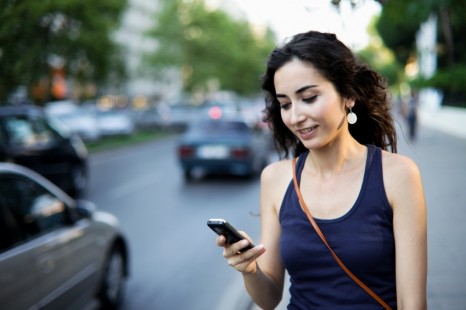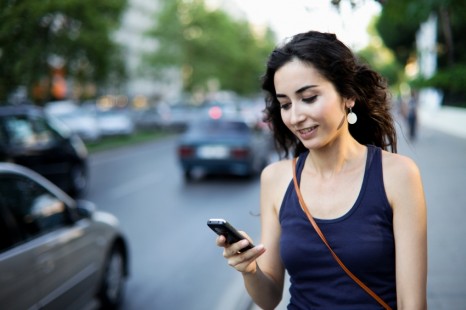 I’d rather be texting.Amidst all the hand-wringing over distracted driving, a critical point is getting lost. The problem isn’t the texting — it’s the driving.
I’d rather be texting.Amidst all the hand-wringing over distracted driving, a critical point is getting lost. The problem isn’t the texting — it’s the driving.
Clive Thompson made this argument in Wired last year:
When we worry about driving and texting, we assume that the most important thing the person is doing is piloting the car. But what if the most important thing they’re doing is texting? How do we free them up so they can text without needing to worry about driving?
The answer, of course, is public transit. In many parts of the world where texting has become ingrained in daily life — like Japan and Europe — public transit is so plentiful that there hasn’t been a major texting-while-driving crisis. You don’t endanger anyone’s life while quietly tapping out messages during your train ride to work in Tokyo or Berlin.
… Dramatically increasing public transit would also decrease our carbon footprint, improve local economies, and curtail drunk driving. (Plus, we’d waste less time in spiritually draining bumper-to-bumper traffic.)
Thompson cites Rich Ling, an American sociologist and expert on the culture of texting, who has moved with his family to Copenhagen. “[Ling] told me that Denmark has so many buses and streetcars that teenagers often don’t bother getting their driver’s license until later in life. ‘My daughter is 18, and she’s only sort of starting to think about driving,’ he says.”
But even though the U.S. lags way behind other developed countries on public transit, American teenagers are increasingly losing interest in driving too. Long gone are the days when a car symbolized ultimate freedom and cruising Main St. was a preferred teen pastime.
In 2008, just 31 percent of American 16-year-olds had their driver’s licenses, down from 46 percent in 1983, according to a new study in the journal Traffic Injury Prevention. The numbers were down for 18-year-olds too, from 80 percent in 1983 to 65 percent in 2008, and the percentage of twenty- and thirtysomethings with driver’s licenses fell as well. And even those with driver’s licenses are trying to drive less; a new survey by car-sharing company Zipcar found that more than half of drivers under the age of 44 are making efforts to reduce the time they spend packed like lemmings into shiny metal boxes.
The decline in driving by younger Americans is fed by many factors: the high cost of gas and insurance at a time of economic insecurity; tighter restrictions on teen drivers in many states; and roads that are more congested than ever, making driving less fun than ever.
But the impact of the internet is big too. “It is possible that the availability of virtual contact through electronic means reduces the need for actual contact among young people,” says Michael Sivak, research professor at the University of Michigan Transportation Research Institute and coauthor of the study on driver’s licenses. “Furthermore, some young people feel that driving interferes with texting and other electronic communication.”
“American youth have fallen out of love with automobiles” because of the rising cost of driving and the fact that they are “living their lives online,” says Wall Street Journal auto columnist Dan Neil. No longer do teenagers need to drive to each others’ houses or the mall to stay in touch with friends; they do it online.
“I don’t think the car symbolizes freedom to Gen Y to the extent it did baby boomers, or to a lesser extent, Gen X-ers,” says Sheryl Connelly, Ford Motor Co.’s global trends and futuring manager. “Part of it is that there are a lot more toys out there competing for the hard-earned dollars of older teens and young adults.”
With younger Americans disproportionately unemployed and burdened by student and personal debt, those dollars are ever harder to come by. You can buy a lot of gadgets for just a fraction of the $8,500 the average American spends each year to maintain a car, not to mention the average cost of buying the car in the first place — more than $29,000 for a new car, or more than $18,000 for a used one.
Plus, Millennials want to live in walkable urban cores instead of suburbs and exurbs that require residents to drive everywhere. And if they do have to drive occasionally, they’re more likely than older Americans to consider car-sharing.
In short, younger Americans are craving an existence with little or no time behind the wheel — and thus little or no opportunity for distracted driving. Unfortunately, our infrastructure and social systems are way behind the times.
Back to Clive Thompson:
Texting while driving is, in essence, a wake-up call to America. It illustrates our real, and bigger, predicament: The country is currently better suited to cars than to communication. This is completely bonkers.
By all means, we should ban texting while driving, or at least try. But we need to work urgently on making driving less necessary in the first place. Let’s get our hands off the wheel and onto the keypad — where they belong.
Amen.
Also check out:
- Car sharing takes a bite out of Americans’ drive time
- The iPhone is the new Prius
- Ask Umbra on how to get rid of your car
- Millennials not looking for McMansions



